Geographically, the United States is a massive country, the third largest in the world. Along with size comes a wide diversity of biomes and natural habitats, so it’s no wonder the U.S. is home to over a thousand species of birds. Just like the vast forests, coastlines, and mountains of the country itself, some of these birds are pretty big. Many large birds are predators and have evolved features like claws, sharp beaks, and an intimidating size to gain an advantage over rival species. For non-predatory species, a large wingspan helps them fly unbelievable distances across deserts and even oceans, without needing to rest. So, what are the largest flying birds in the United States, by wingspan?
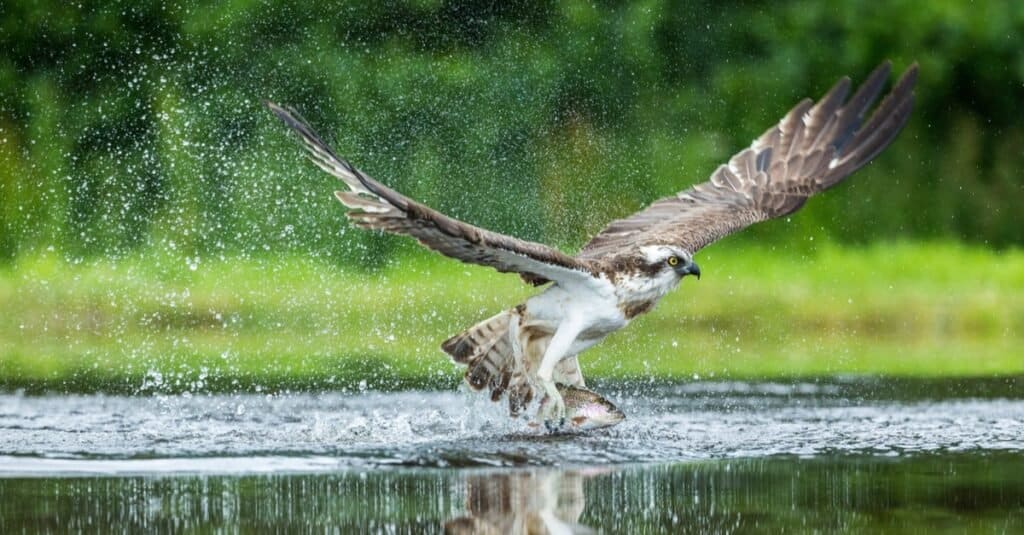
This osprey just manages to take off with a heavy rainbow trout firmly grasped in its talons.
©LMIMAGES/Shutterstock.com
1. California Condor – 9’10″
The largest bird in the United States or anywhere in North America, is the California condor. With a wingspan of 9’ 10,” this biggest of big birds resides mostly in California, choosing large trees and high mountains as its home. The California condor is a scavenger, traveling up to 160 miles in search of carrion. Unfortunately, the destruction of their natural habitats and the use of agricultural chemicals has led to a serious decline in the condor population, putting them in a “critically endangered” conservation status. At one point there were only 27 condors left in existence! But conservation efforts since have brought the numbers up to 537 – a surprising success story!
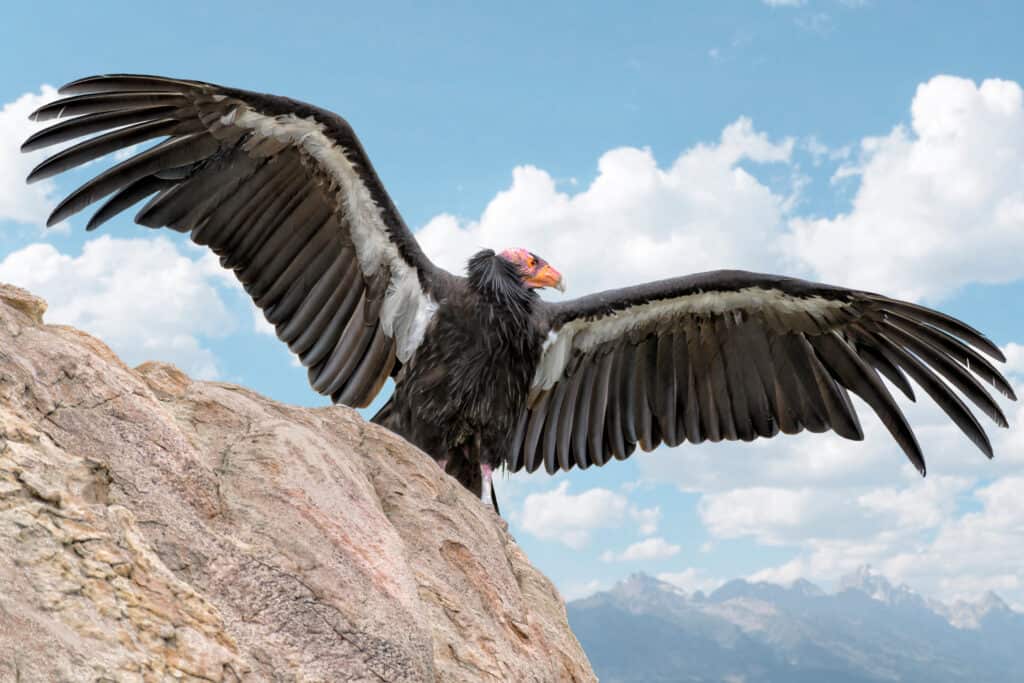
California condors are bouncing back from near extinction.
©Barbara Ash/Shutterstock.com
2. American White Pelican – 9′
The American White Pelican has a big 9-foot wingspan, making it an outstanding flyer. However, it does not dive from the air for its prey, but instead paddles around on the surface of the water and scoops up passing fish and other aquatic life with its bill. This species sometimes cooperates to capture food by forming a line and forcing fish into shallower water. The American White Pelican lives mostly inland around lakes and wetlands. It spends its winters along the coast in the comfort of shallow bays protected from the worst of the weather. Some of these birds live permanently in the warm climate of Florida or coastal Texas and Mexico, but most migrate from the northern plains down to the coastal areas of the southeast. The number of these birds has been increasing over the past 50 years.
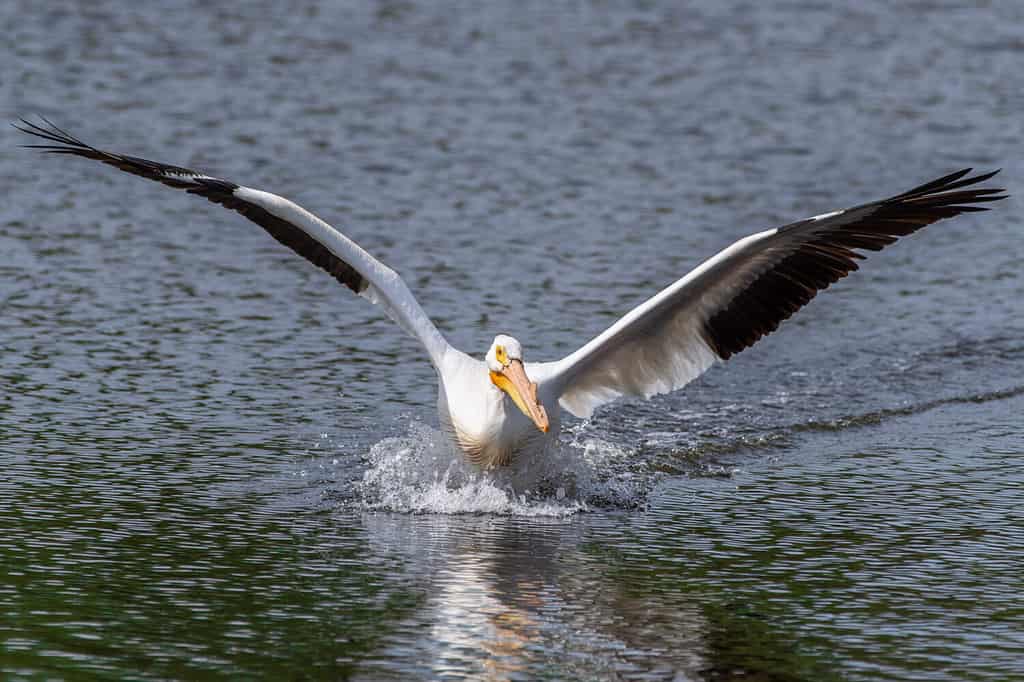
The American White Pelican does not dive for food, but swims on the surface and scoops up fish with its bill.
©Mike Lynds/Shutterstock.com
3. Trumpeter Swan – 8’2”
The trumpeter swan is the second largest bird in the U.S., with a maximum wingspan of 8’ 2.’’ It is the largest waterfowl in North America. Surviving mostly off insects and water plants, the trumpeter swan lives mostly in the midwestern states, with some populations in the Rocky Mountains and Alaska. Trumpeter swans have a signature call from which they get their name, which distinguishes them from their cousins, the mute swans. Trumpeter swans almost went extinct, with only 70 remaining in 1933. However, conservation efforts have been wildly successful. Today their global population is 63,000 and they are now in the “least concern” conservation status.

Trumpeter swans have something to trumpet about. Their numbers have grown from just 70 in 1933, to 63,000 today!
©iStock.com/Zeke1
4. Magnificent Frigatebird – 8’
The magnificent frigatebird is a tropical giant that ranges as far west as Baja California, Mexico, and as far east as Cape Verde, Africa. In the U.S., you can find them around the Gulf of Mexico, mainly in Florida. They usually hunt surface-dwelling fish but also bully other birds to steal their food. You can’t miss a male frigatebird, as they have a shockingly red throat that they puff out to attract a mate. It’s beautiful but also looks a little like a medical emergency, to be honest. Currently, the magnificent frigatebird is at a “least concern” conservation status. With an 8’ wingspan, the way it bullies rival birds, and its game with the girls, this intimidating giant probably won’t have to worry about extinction any time soon.
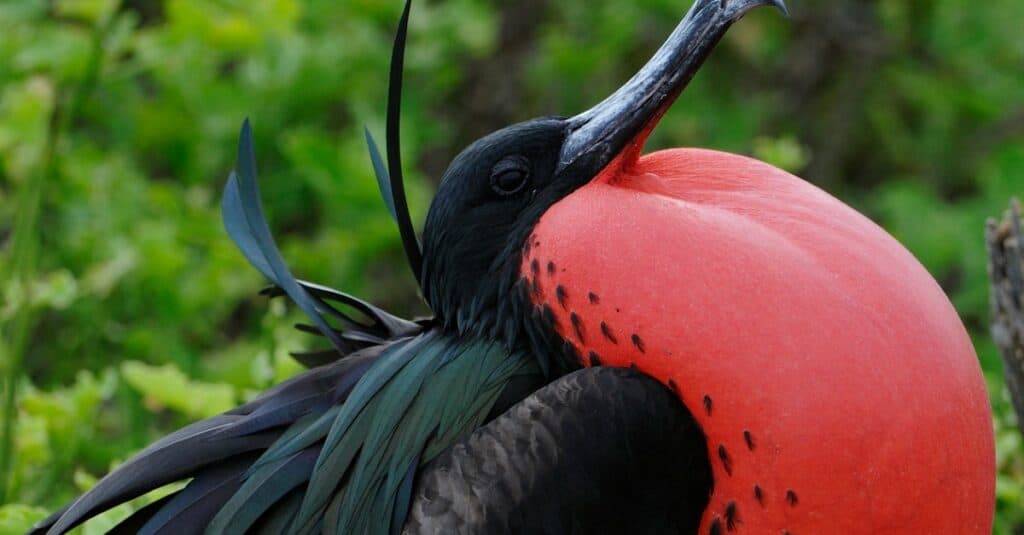
A male magnificent frigatebird showing off for the girls.
©iStock.com/Clay Clark
5. Golden Eagle – 7’7’’
The first raptor (bird of prey) on this list is the golden eagle. They live in North America, Europe, Asia, and even some parts of Africa. With so many of them in so many places, it makes sense their conservation status is “least concern.” They hunt mostly small mammals such as rabbits, and because of this, they’ve been a popular choice in falconry for hundreds of years. Golden Eagles are not picky in choosing their homes, living in steep cliffs, massive treetops, and even the barren tundra. With a 7’ 7’’ wingspan, golden eagles get around. Approximately 30,000 of them live in the United States.
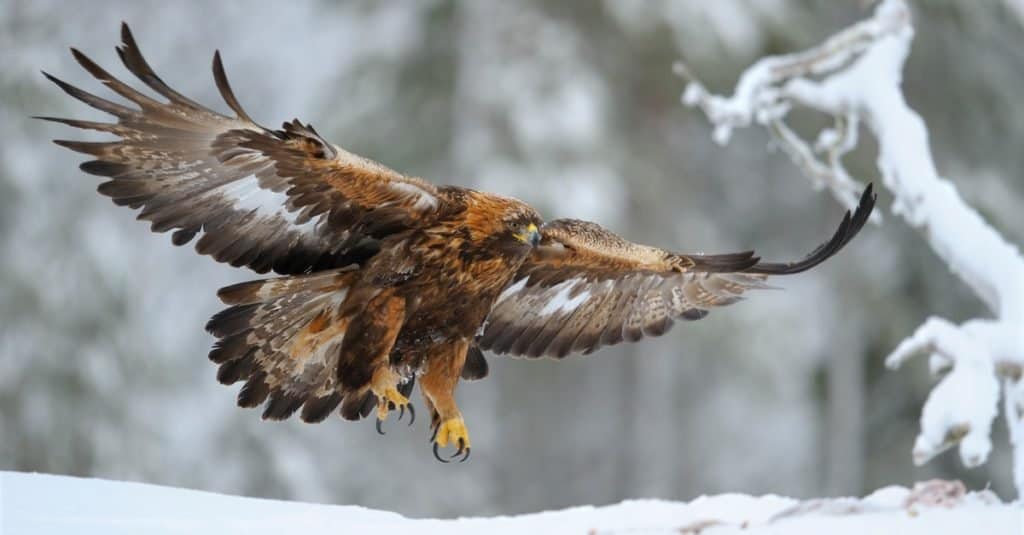
The largest golden eagle nest on record was 20 feet tall and 8.5 feet wide!
©Vladimir Kogan Michael/Shutterstock.com
6. Whooping Crane – 7’7”
At a height of 5’ 3’’ and a wingspan of 7’ 7’’ the whooping crane ties with the golden eagle in wingspan. It is the largest of the two American crane species, and the tallest species of bird native to the United States. Like most cranes, it sustains itself on an omnivorous diet of aquatic plants and animals but is more inclined to eat live prey than other cranes. The whooping crane is a rare bird, having almost gone extinct in 1941, and today still has a conservation status of “threatened.” They prefer swamps and marshy terrain. They can only be found in their breeding grounds in Wisconsin and living in small parts of Louisiana and Florida. Currently, they number 75, with most of that number having been bred in captivity before being released in the wild.
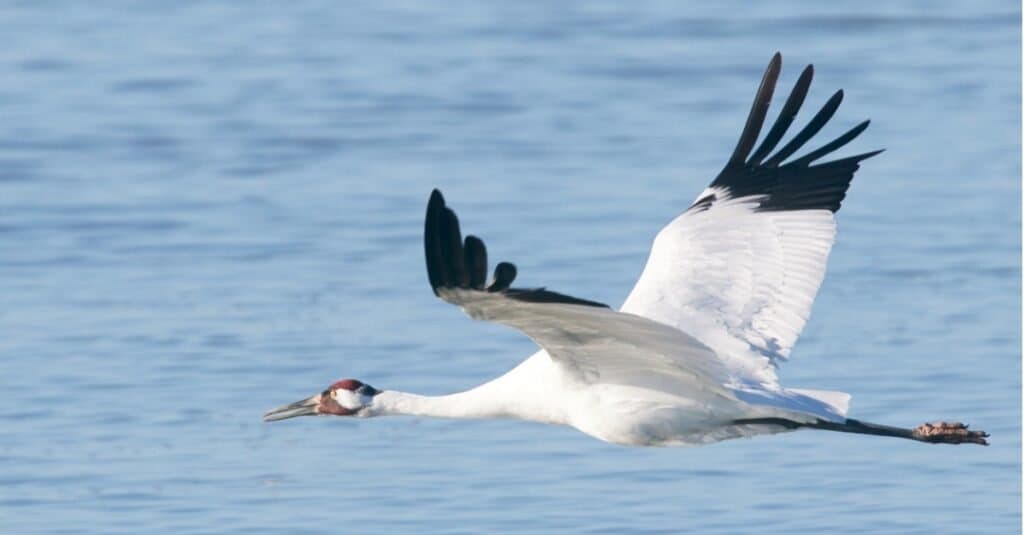
The whooping crane is close to extinction. Most of the remaining 75 individuals were bred in captivity before being released in the wild.
©iStock.com/kellington1
7. Brown Pelican – 7’6″
The brown pelican is the smallest species of pelican, but still measures in at a stunning maximum wingspan of 7’6’’, one foot and nine inches wider than the average American man is tall. They have a conservation status of “least concern” and reside along U.S. coastlines. The state of Louisiana even made it their state bird and included it on the state flag and seal.
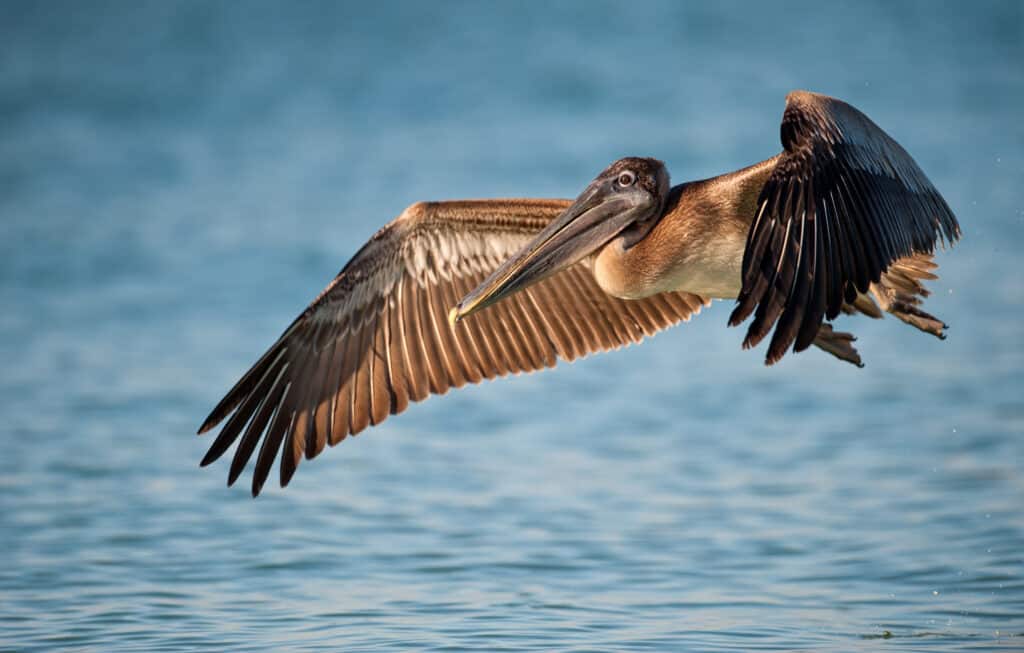
The brown pelican is the state bird of Louisiana and is depicted on the state flag and seal.
©Nagel Photography/Shutterstock.com
8. Bald Eagle – 7’5’’
Of course, the national bird of the United States has to have a spot on this list. Measuring in at 7’ 5’’ the bald eagle is only two inches smaller than the golden eagle. Unlike its golden cousin, the bald eagle prefers a diet of fish over small mammals. With its signature white head and dark brown body, the bald eagle resides in 49 states (not Hawaii), Canada, and Mexico. With over 300,000 individuals, this species is at a “least concern” conservation status. Conservationists removed them from the endangered species list in 2007.
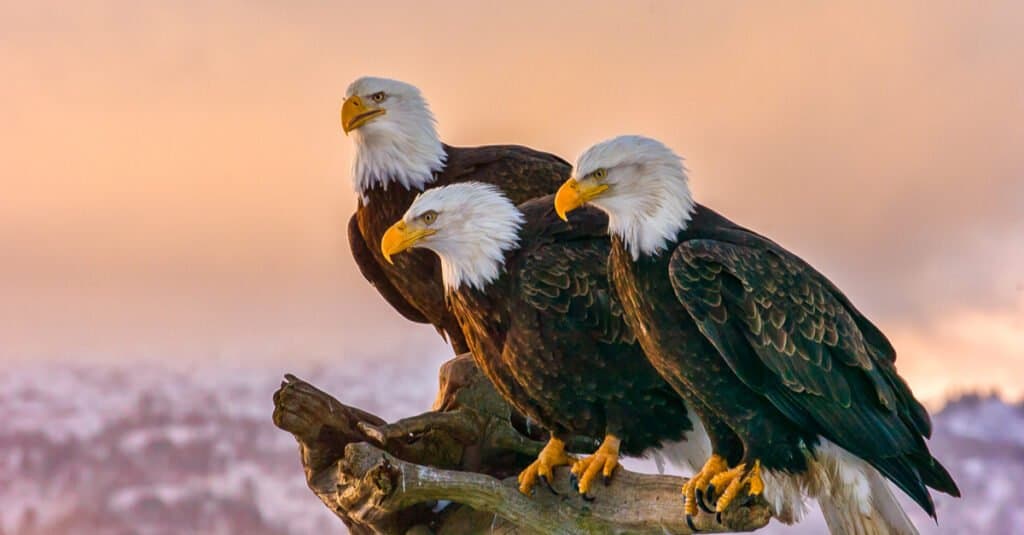
The bald eagle is a conservation success story, with over 300,000 specimens in the United States today.
©FloridaStock/Shutterstock.com
9. Black-Footed Albatross – 7’2’’
The 7’ 2’’ black-footed albatross is the largest of the three albatross species in the Northern Hemisphere. These seabirds survive on fish, squids, and crustaceans, and dwell on islands and around coasts. Chances are, if you live in the lower 48 states, you haven’t seen a black-footed albatross. In the U.S., they only live in the Hawaiian Islands and off the Alaska coastline. Unfortunately, the black-footed albatross is often the victim of longline fishing accidents, which has led to its conservation status being “near threatened.” There are about 60,000 left in the world and they continue to decline. Fishing is prohibited in a 50-mile radius of their U.S. nesting grounds.
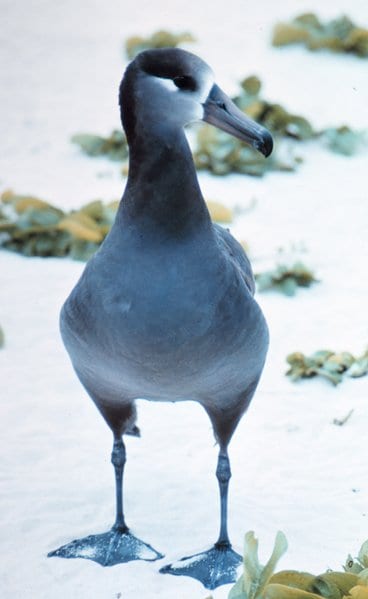
There are about 60,000 black-footed albatrosses left worldwide.
©Dr. James P. McVey / Public domain, from Wikimedia Commons, the free media repository – License
10. Laysan Albatross – 6’6’’
The second species of Northern Hemisphere albatrosses is the Laysan albatross. It measures eight inches smaller than the black-footed albatross, at a maximum wingspan of 6’ 6’’. Like its cousin, it feeds on aquatic animals, has a “near threatened” conservation status, and lives in Hawaii and off the coast of Alaska. The oldest one on record, a female named “Wisdom” is at least 71 years old and still going strong, returning to Midway Island every year to nest. Bird conservationists have banded her and studied her for decades.
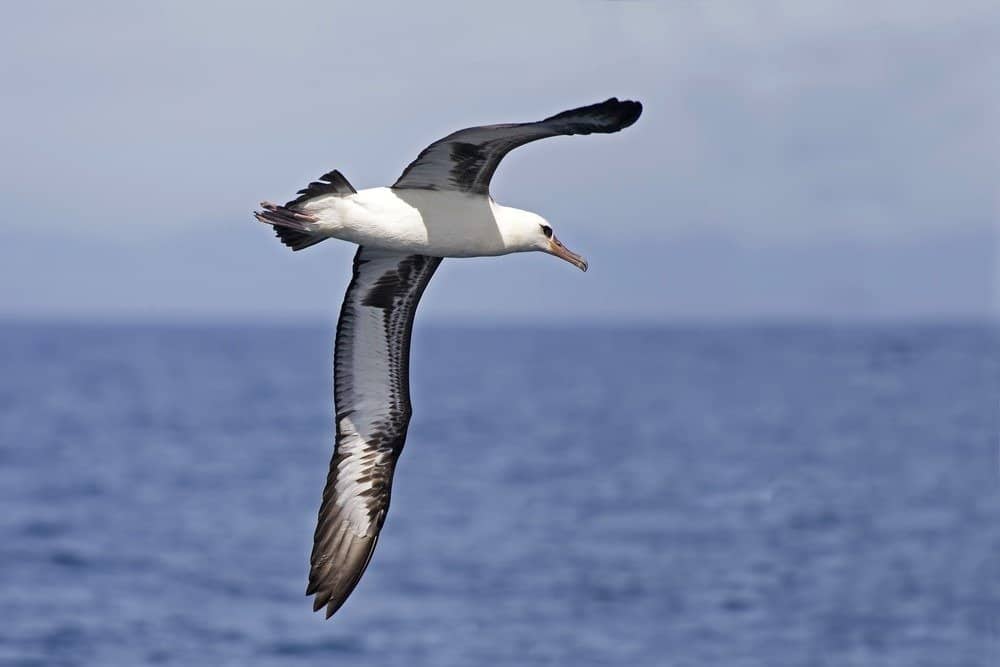
The Laysan albatross is one of the longest-lived bird species on Earth. The oldest is at least 71 years old.
©Harold Stiver/Shutterstock.com
11. Great Blue Heron – 6’5”
Possibly the most commonly sighted bird on this list is the great blue heron. Often mistaken for a crane, this giant with a 6’ 5’’ wingspan is at a conservation status of “least concern.” They live everywhere in the contiguous U.S., as well as all of Mexico, Central America, and the Caribbean. The great blue heron eats primarily fish, and hunts in all sorts of bodies of water: rivers, marshes, lakes, and the ocean.
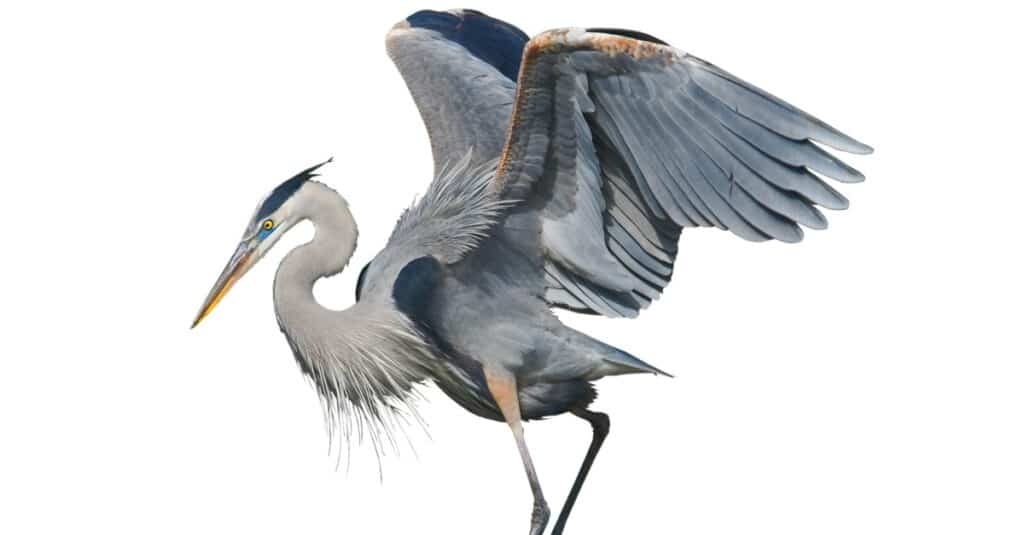
Great blue herons are beautiful and plentiful in the United States.
©Tathoms/Shutterstock.com
12. Sandhill Crane – 6’5’’
The sandhill crane is the second largest crane species in the United States. With a wingspan of 6’ 5’’ it’s, a full one foot and two inches smaller than the whooping crane. Unlike the whooping crane, the sandhill is not endangered at all, making its conservation status “least concern.” These hardy birds survive anywhere from the beaches of Florida to the Siberian Tundra, where they live at natural water sources throughout the western U.S., eating a diverse range of berries, grains, insects, and small animals of all sorts. They are named for the sandhills of Central and Western Nebraska, through which they migrate annually in early spring.
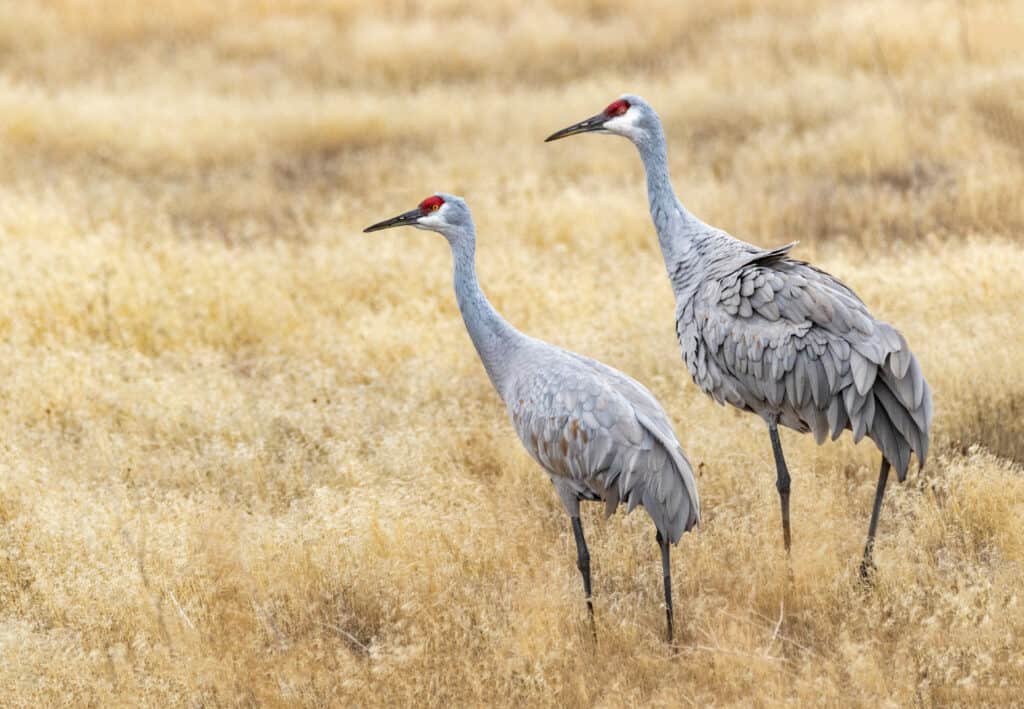
These hardy birds survive anywhere from the beaches of Florida to the Siberian Tundra.
©Michael Chatt/Shutterstock.com
13. Osprey – 6’
Even the smallest bird on this list is a giant. Measuring at a maximum wingspan of 6’ the Osprey is wider than most men are tall. Ospreys have a conservation status of “least concern” and live on every continent except Antarctica. In the U.S., they reside mostly along the coasts. Ospreys are raptors who live and hunt near bodies of water. They particularly prey upon small mammals that live near the water or come there for a drink.

Ospreys hunt kokanee salmon from lakes.
©Gregory Johnston/Shutterstock.com
Ways You Can Help Conserve Endangered Birds
In the past, birds in the U.S. were often displaced and over-hunted, nearly to the point of extinction, but today scientists are working to bring them back. Some birds like the California condor and whooping crane will take some more time, but others like the trumpeter swan and bald eagle have made amazing comebacks, and are now an everyday part of natural life in the U.S.
Here are some simple things you can do to help conserve endangered birds, of any size:
- Join a conservation group to donate financially and advocate politically for the species of your choice.
- Don’t let pets, such as cats, roam free. Cats kill birds. And some large birds can kill cats.
- Don’t use chemicals for pest control. Poisoning rats or mice can poison other creatures that eat them.
- Secure garbage in bags and bins that birds cannot get into.
- If you are a hunter, familiarize yourself with the laws about hunting bird species in your area.
- Plant native plant species to increase the natural habitat of indigenous birds.
- Stay away from bird nests, do not stress the birds and cause them to seek new homes because of humans being too close and too curious.
- Support National Parks that are working to conserve natural habitats.
Summary Of The Largest Flying Birds In The United States By Wingspan
| Rank | Bird | Wingspan |
|---|---|---|
| 1 | California Condor | 9’ 10″ |
| 2 | American White Pelican | 9′ |
| 3 | Trumpeter Swan | 8’ 2” |
| 4 | Magnificent Frigatebird | 8’ |
| 5 | Golden Eagle | 7’ 7” |
| 6 | Whooping Crane | 7’ 7” |
| 7 | Brown Pelican | 7’ 6″ |
| 8 | Bald Eagle | 7’ 5’’ |
| 9 | Black-Footed Albatross | 7’ 2’’ |
| 10 | Laysan Albatross | 6’ 6’’ |
| 11 | Great Blue Heron | 6’ 5” |
| 12 | Sandhill Crane | 6’ 5’’ |
| 13 | Osprey | 6’ |
The photo featured at the top of this post is © Jack Molan/Shutterstock.com
Thank you for reading! Have some feedback for us? Contact the AZ Animals editorial team.







